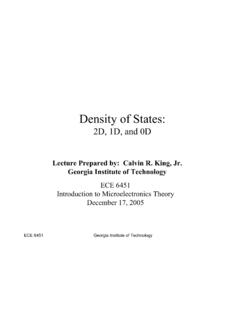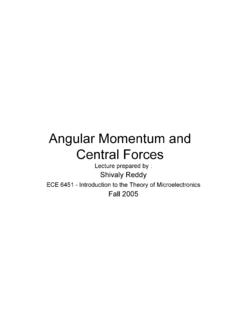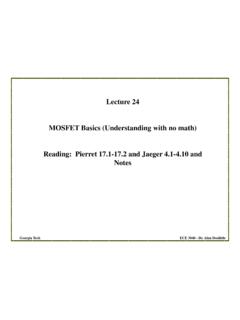Transcription of ECE3080-L-4-Density of states fermi energi
1 ECE 3080 - Dr. Alan DoolittleGeorgia TechLecture 4 Density of states and fermi Energy ConceptsReading: (Cont d) Notes and Anderson2sections 3080 - Dr. Alan DoolittleGeorgia TechHow do electrons and holes populate the bands?Density of states ConceptIn lower level courses, we state that Quantum Mechanics tells us that the number of available states in a cubic cm per unit of energy, the density of states , is given by:eVcmStatesofNumberunitEEEEmmEgEEEEmmE gvvppvccnnc 332**32**,)(2)(,)(2)( ECE 3080 - Dr. Alan DoolittleGeorgia TechHow do electrons and holes populate the bands?Density of states ConceptThus, the number of states per cubic centimeter between energy E and E +dE isotherwiseandand0,EE if )dE(E g,EE if )dE(E gvvcc But where does it come from?
2 ECE 3080 - Dr. Alan DoolittleGeorgia TechHow do electrons and holes populate the bands?Where Does the Density of states Concept come from?Approach: 1. Find the smallest volume of k-space that can hold an electron. This will turn out to be related to the largest volume of real space that can confine the Next assume that the average energy of the free electrons (free to move), the fermienergy Ef, corresponds to a wave number kf. This value of kf, defines a volume in k-space for which all the electrons must be within. 3. We then simply take the ratio of the total volume needed to account for the average energy of the system to the smallest volume able to hold an electron ant that tells us the number of From this we can differentiate to get the density of states 3080 - Dr.
3 Alan DoolittleGeorgia TechHow do electrons and holes populate the bands?Derivation of Density of states ConceptFirst a needed tool: Consider an electron trapped in an energy well with infinite potential barriers. Recall that the reflection coefficient for infinite potential was 1 so the electron can not penetrate the Neudeck and Pierret Figure 2222n222222222222 Eand sin)( ,2 1,nfor ank 0kaAsin 0(a)0 B 0)0( :ConditionsBoundary 2or E 22k wherecossin)( :Solution General0022manaxnAxmkmEkxBkxAxkxExmEVmnn ECE 3080 - Dr. Alan DoolittleGeorgia TechHow do electrons and holes populate the bands?Derivation of Density of states ConceptWhat does it mean?After Neudeck and Pierret Figure ,d,e2222n2 Eand sin)(manaxnAxnn A standing wave results from the requirement that there be a node at the barrier edges ( BC s: (0)= (a)=0 ).
4 The wavelength determines the energy. Many different possible states can be occupied by the electron, each with different energies and 3080 - Dr. Alan DoolittleGeorgia TechHow do electrons and holes populate the bands?Derivation of Density of states ConceptWhat does it mean?After Neudeck and Pierret Figure Eand sin)(manaxnAxnn Recall, a free particle has E ~k2. Instead of being continuous in k2, E is discrete in n2! the energy values (and thus, wavelengths/k) of a confined electron are quantized (take on only certain values). Note that as the dimension of the energy well increases, the spacing between discrete energy levels (and discrete k values) reduces.
5 In the infinite crystal, a continuum same as our free particle solution is for much larger a . Note: offset vertically for 3080 - Dr. Alan DoolittleGeorgia TechHow do electrons and holes populate the bands?Derivation of Density of states ConceptWe can use this idea of a set of states in a confined space ( 1D well region) to derive the number of states in a given volume (volume of our crystal).Consider the surfaces of a volume of semiconductor to be infinite potential barriers ( the electron can not leave the crystal). Thus, the electron is contained in a 3D Neudeck and Pierret Figure and E 22k wherecz0 b,y0 a, 0022222222222222222 ECE 3080 - Dr. Alan DoolittleGeorgia TechHow do electrons and holes populate the bands?
6 Derivation of Density of states ConceptUsing separation of 0)()(1 ,0)()(1 ,0)()(10)()(1)()(1)()( we(2)by dividing and (1) into (2) Inserting)()()(),,( (2) 0 (1)zyxzzzyyyxxxzzyyxxzyxkkkkwherekzzzkyy ykxxxkzzzyyyxxxzyxzyxkzyx Since k is a constant for a given energy, each of the three terms on the left side must individually be equal to a this is just 3 equivalent 1D solutions which we have already 3080 - Dr. Alan DoolittleGeorgia TechHow do electrons and holes populate the bands?Derivation of Density of states ConceptCont 22222222nz ny, nx,zzyyxx2 ,2 1,nfor ,ank ,ank ,ank wheresinsinsin),,()()()(),,( cnbnanmzkykxkAzyxzyxzyxzyxzyxzyx 0a b c kxkykzEach solution ( each combination of nx, ny, nz) results in a volume of k-space.
7 If we add up all possible combinations, we would have an infinite solution. Thus, we will only consider states contained in a fermi -sphere (see next page).ECE 3080 - Dr. Alan DoolittleGeorgia TechHow do electrons and holes populate the bands?Derivation of Density of states ConceptCont electron average for the valuemomentum a defines 2E mkf Volume of a single state cube : V3state single Vcba Volume of a fermi -sphere : 34V3sphere- fermi fk A fermi -Sphere is defined by the number of states in k-space necessary to hold all the electrons needed to add up to the average energy of the crystal (known as the fermi energy). V is the physical volume of the crystal where as all other volumes used here refer to volume in k-space.
8 Note that: Vsingle-stateis the smallest unit in k-space. Vsingle-stateis required to hold a single 3080 - Dr. Alan DoolittleGeorgia TechHow do electrons and holes populate the bands?Derivation of Density of states ConceptCont volume of a single state cube : V3state single Vcba k-space volume of a fermi -sphere : 34V3sphere- fermi fk Number of filled states in a fermi -sphere:2333sin3 4 342121212N ffstateglespherefermikVVkxxxVV Correction for allowing 2 electrons per state (+/- spin)Correction for redundancy in counting identical states resulting from +/- nx, +/- ny, +/- nz. Specifically, sin(- )=sin(+ ) so the state would be the same. Same as counting only the positive octant in 3080 - Dr.
9 Alan DoolittleGeorgia TechHow do electrons and holes populate the bands?Derivation of Density of states ConceptCont of filled states in a fermi -sphere:312f233k 3 N VNkVf Efvaries in Si from 0 to ~ eV as n varies from 0 to ~5e21cm-3 density electron theis n where23 E 23 2E3222f322222fmnmVNmkf 232223233 N mEVkVf Thus, ECE 3080 - Dr. Alan DoolittleGeorgia TechHow do electrons and holes populate the bands?Derivation of Density of states ConceptCont G(E)223 23 G(E)VdEdNper volumeenergy per states of # G(E) 232223233 N mEVkVf Applying to the semiconductor we must recognize m m* and since we have only considered kinetic energy (not the potential energy) we have E E-EccEE 32**2mm G(E) Finally, we can define the density of states function:ECE 3080 - Dr.
10 Alan DoolittleGeorgia TechHow do electrons and holes populate the bands?Probability of Occupation ( fermi Function) ConceptNow that we know the number of available states at each energy, how do the electrons occupy these states ?We need to know how the electrons are distributed in energy .Again, Quantum Mechanics tells us that the electrons follow the fermi -distribution function .)(~,tan11)()(crystaltheinenergyaveragee nergyFermiEandKelvinineTemperaturTtconsB oltzmankwhereeEfFkTEEF f(E) is the probability that a state at energy E is occupied1-f(E) is the probability that a state at energy E is unoccupiedECE 3080 - Dr. Alan DoolittleGeorgia TechHow do electrons and holes populate the bands?









